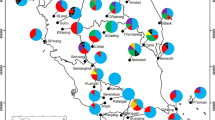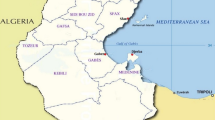Abstract
Genetic variation within and among populations is the basis for survival of the populations both in short and long term. Thus, studying the plant genetic diversity is essential for any conservation program. In this research, inter-simple sequence repeat (ISSR) was used to unravel the genetic variability and relationships across 75 wild individuals of Satureja rechingeri. Amplification of genomic DNA using 13 ISSR primers yielded 145 products, of which 115 products were polymorphic revealing 79.09 % polymorphism. The average polymorphism information content value obtained was 0.35. Furthermore, marker index (3.13) and resolving power (10.03) indicated that the ISSR marker was efficient revealing the genetic diversity of S. rechingeri. Averages of Shannon’s information index (I) and gene diversity (He) were 0.44 and 0.30, respectively. Analysis of molecular variance showed that the genetic variation was found mainly within populations (89 %), but variance among populations was only 11 %. The marker data indicated that the studied germplasm of S. rechingeri has a high level of diversity, and four reconstructed main clusters were identified by Bayesian analysis. The unweighted pair group method with arithmetic mean dendrogram grouped the samples by origin in most cases which was also confirmed by Bayesian analysis. These results have an important implication for S. rechingeri germplasm characterization, improvement, and conservation.





Similar content being viewed by others
References
Behravan J, Ramezani M, Kasaian J, Sabeti Z (2004) Antimycotic activity of the essential oil of Satureja mutica Fisch & C.A. Mey from Iran. Flavour Fragrance J 19:421–423
Bhagyawant SS, Srivastava N (2008) Genetic fingerprinting of chickpea (Cicerarietinum L.) germplasm using ISSR markers and their relationships. Afr J Biotech 7:4428–4481
Bostein D, White RL, Sholnick M, David RW (1980) Construction of a genetic linkage map in man using restriction fragment length polymorphism. Am J Hum Genet 32:314–331
Doyle JJ, Doyle JL (1991) Isolation of plant DNA from fresh tissue. Focus 12:13–15
Evanno G, Regnaut S, Goudet J (2005) Detecting the number of clusters of individuals using the software STRUCTURE: a simulation study. Mol Ecol 14:2611–2620
Falush D, Stephens M, Pritchard JK (2007) Inference of population structure using multilocus genotype data: dominant markers and null alleles. Mol Ecol Notes 7:574–578
Fracaro F, Echeverrigaray S (2006) Genetic variability in Hesperozygis ringens Benth. (Lamiaceae), an endangered aromatic and medicinal plant of Southern Brazil. Biochem Genet 44:479–490
Hadian J, Khadivi-Khub A (2014) Relationships among fourteen species of Satureja growing wild in Iran detected with molecular markers. Pl Biol (Stuttgart). doi:10.1111/plb.12162
Hadian J, Tabatabaei SMF, Naghavi MR, Jamzad Z, Ramak-Masoumi T (2008) Genetic diversity of Iranian accessions of Satureja hortensis L. based on horticultural traits and RAPD markers. Sci Hort (Amsterdam) 115:196–202
Hamrick JL, Godt MJW (1996) Effects of life history traits on genetic diversity in plant species. Philos Trans R Soc Lond Ser B Biol Sci 351:1291–1298
Hamrick JL, Godt MJW, Sherman-Broyles SL (1992) Factors influencing levels of genetic diversity in woody plant species. New Forest 6:95–124
Jamzad Z (1996) Satureja rechingeri (Labiatae)—a new species from Iran. Ann Naturhist Mus Wien 98:75–77
Joshi-Saha A, Gopalakrishna T (2007) Inheritance and tagging of gene regulating flowering time in the green manure crop Sesbania rostrata (Bremek. & Obrem.). Mol Breed 20:389–399
Kameli M, Hesamzadeh Hejazi SM, Ebadi M (2013) Assessment of genetic diversity on populations of three Satureja species in Iran using ISSR markers. Ann Biol Res 4(3):64–72
Karaman S, Digrak M, Ravid U, Ilcim A (2001) Antibacterial and antifungal activity of the essential oils of Thymus revolutus Celak from Turkey. J Ethnopharmacol 76:183–186
Khadivi-Khub A, Salehi-Arjmand H, Movahedi K, Hadian J (2014a) Molecular and morphological variability of Satureja bachtiarica in Iran. Pl Syst Evol. doi:10.1007/s00606-014-1055-3
Khadivi-Khub A, Karimi E, Hadian J (2014b) Population genetic structure and trait associations in forest savory using molecular, morphological and phytochemical markers. Gene. doi:10.1016/j.gene.2014.05.062
Li A, Ge S (2006) Genetic variation and conservation of Changnienia amoena, an endangered orchid endemic to China. Pl Syst Evol 258:251–260
Li Z, Nelson RL (2002) RAPD marker diversity among cultivated and wild soybean accessions from four Chinese provinces. Crop Sci 42:1737–1744
Liu J, Wang L, Geng Y, Wang Q, Luo L, Zhong Y (2006) Genetic diversity and population structure of Lamiophlomis rotate (Lamiaceae), an endemic species of Qinghai-Tibet Plateau. Genetica 128:385–394
Nei M (1973) Analysis of gene diversity in subdivided populations. Proc Natl Acad Sci USA 70:3321–3323
Nybom H (2004) Comparison of different nuclear DNA markers for estimating intraspecific genetic diversity in plants. Mol Ecol 13:1143–1155
Peakall R, Smouse PE (2006) GenAIEx 6: genetic analysis in Excel. Population genetic software for teaching and research. Mol Ecol Notes 6:288–295
Powell W, Morgante M, Andre C, Hanafey Mm, Vogel J, Tingey S, Rafalski A (1996) The comparison of RFLP, RAPD, AFLP and SSR (microsatellite) markers for germplasm analysis. Mol Breed 2:225–238
Prevost A, Wilkinson MJ (1999) A new system of comparing PCR primers applied to ISSR fingerprinting of potato cultivars. Theor Appl Genet 98:107–112
Pritchard JK, Stephens M, Donnelly P (2000) Inference of population structure using multilocus genotype data. Genetics 155:945–959
Qi X, Pittaway TS, Lindup S, Liu H, Waterman E, Padi FK, Hash CT, Zhu J, Gale MD, Devos KM (2004) An integrated genetic map and a new set of simple sequence repeat markers for pearl millet, Pennisetum glaucum. Theor Appl Genet 109:1485–1493
Reddy MP, Sarlan N, Siddiq EA (2002) Inter-simple sequence repeat (ISSR) polymorphism and its application in plant breeding. Euphytica 128:9–17
Rohlf FJ (1998) On applications of geometric morphometrics to studies of ontogeny and phylogeny. Syst Biol 47:147–158
Rohlf FJ, Sokal RR (1981) Comparing numerical taxonomic studies. Syst Zool 30:459–490
Romesburg HC (1990) Cluster analysis for researchers. Krieger Publishing, Malabar
Sefc KM, Lopez MS, Lefort F, Botta R (2000) Microsatellites variability in grapevine cultivars from different European regions and evaluation of assignment testing to assess the geographic origin of cultivars. Theor Appl Genet 100:498–505
Sefidkon F, Jamzad Z (2005) Chemical composition of the essential oil of three Iranian Satureja species (S. mutica, S. macrantha and S. intermedia). Food Chem 91:1–4
Sefidkon F, Abbasi K, Jamzad Z, Ahmadi S (2007) The effect of distillation methods and stage of plant growth on the essential oil content and composition of Satureja rechingeri Jamzad. Food Chem 100:1054–1058
Sehgal D, Rajpal VR, Raina SN, Sasanuma T, Sasakuma T (2009) Assaying polymorphism at DNA sequence level for new and novel genetic diversity diagnostics of the safflower (Carthamus tinctorius L.) world germplasm resources. Genetica 135(3):457–470
Semagn K, Bjørnstad Å, Ndjiondjop MN (2006) An overview of molecular marker methods for plants. Afr J Biotechnol 5(25):2540–2568
Shannon CE, Weaver W (1949) The mathematical theory of communication. University of Illinois Press, Urban
Sokal RR, Michener CD (1958) Statistical method for evaluating systematic relationships. Univ Kans Sci Bull 38:1409–1438
Sokal RR, Sneath PHA (1963) Principle of numerical taxonomy. Freeman, San Francisco
Song ZQ, Li XF, Wang HG, Wang JH (2010) Genetic diversity and population structure of Salvia miltiorrhiza Bge in China revealed by ISSR and SRAP. Genetica 138:241–249
Timmappaiah WG, Shobha G, Melwyn S (2009) Assessment of genetic diversity in Cashew germplasm using and ISSR markers. Sci Hort (Amsterdam) 120:411–417
Van der Nest MA, Steenkamp ET, Wingfield BD, Wingfield MJ (2000) Development of simple sequence repeat (SSR) markers in Eucalyptus from amplified inter-simple sequence repeats (ISSR). Plant Breed 119:433–436
Vijayan K, Srivatsava PP, Nair CN, Awasthi AK, Tikader A, Sreenivasa B, Urs SR (2006) Molecular characterization and identification of markers associated with yield traits in mulberry using ISSR markers. Plant Breed 125:298–301
Wu YG, Guo QS, He Lin YF, Luo LJ, Liu GD (2010) Genetic diversity analysis among and within populations of Pogostemon cablin from China with ISSR and SRAP markers. Biochem Syst Ecol 38:63–72
Yeh FC, Yang RC, Boyle T (1999) POPGENE Version 1.31, Microsoft Window-based freeware for population genetic analysis. University of Alberta and Centre for International Forestry Research
Zaghloul M, Reisch C, Poschlod P (2013) Soil seed bank contributes significantly to genetic variation of Hypericum sinaicum in a changing environment. Pl Syst Evol 279:1819–1828
Zhao KG, Zhou MQ, Chen LQ (2007) Genetic diversity and discrimination of Chimonanthus praecox (L.) Link germplasm using ISSR and RAPD markers. Hort Sci (Calcutta) 42:1144–1148
Acknowledgment
The authors would like to thank Iranian National Science Foundation (INSF) for their financial support.
Author information
Authors and Affiliations
Corresponding author
Rights and permissions
About this article
Cite this article
Hadian, J., Karami, A., Azizi, A. et al. Ubiquitous genetic diversity among and within wild populations of Satureja rechingeri assessed with ISSR markers. Plant Syst Evol 301, 923–930 (2015). https://doi.org/10.1007/s00606-014-1126-5
Received:
Accepted:
Published:
Issue Date:
DOI: https://doi.org/10.1007/s00606-014-1126-5




